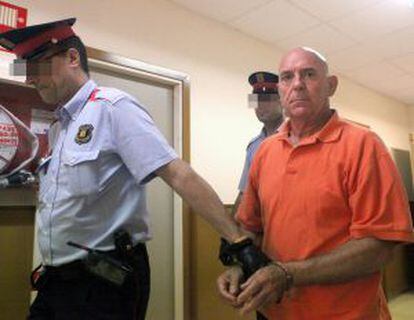No body, no crime? On the trail of Spain’s ‘perfect’ murderers
The lack of a corpse is no obstacle to making convictions in missing persons cases


On September 11, 2008, 23-year-old Joaquín Fernández set out from the coast of Almería aboard a yacht and was never seen again. According to the person with him, the pair were going to pick up a shipment of drugs, but the engine ran out of fuel, and they decided to try to swim to shore. But Fernández’s body was never found, and his companion was eventually picked up, allegedly after spending seven hours in the water, with no signs of hypothermia. The man, whom police have not identified, gave several versions to the authorities of what supposedly happened. The eight-meter yacht, which had been stolen, was later found 23 nautical miles against the tide from where a fishing boat had found the survivor. The story didn’t add up.
Around 800 people a year go unaccounted for – two per day, according to Interior Ministry data
Seven years later, Joaquín Fernández’s father continues to believe that his son was murdered. But there is no body, no weapon, and nobody has confessed. The investigating judge was only able to charge the other man aboard the vessel with failing to help rescue Fernández. Case closed. No body, no crime, as they say. “Trying to find out what happened without a body can be almost impossible,” says the victim’s father, who has set up SOS Desaparecidos (SOS Missing) to look into similar cases. “But with so many contradictions and lies, the person who has not told the truth should have to prove their innocence with evidence, not the other way round.”
Each year, dozens of people go missing in Spain, and it is impossible to know how many of them might have been murdered. The police admit that with no evidence of wrongdoing, there is little they can do, and the cases are soon filed away.
In January 2013, the Interior Ministry released figures on missing persons in Spain for the first time. They revealed that, between 2010 and 2012, 29,607 such reports were filed with the police, of which 27,279 were resolved. Which means that around 800 people a year go unaccounted for – that’s two per day. Many of them do not want to be found, but some, say organizations such as SOS Desaparecido, will have been murdered.

Getting rid of a body is relatively easy – with the right planning. In the case of a recent double murder in Cuenca province, the alleged killer had dug one grave and bought enough quicklime to dispose of one body, but when the victim appeared with a friend, whom he also killed, his task was made twice as difficult and he botched the burial. A passer-by noticed the shallow grave and alerted the authorities.
In short, say Spain’s police, there’s no such thing as the perfect crime. Not that some killers haven’t come close. In March 2009, Ramón Laso murdered his wife and her brother in Tarragona province. He had already served time for murdering his first wife and her son. But this time his planning was more careful, and he managed to dispose of the two bodies and the murder weapon, which were never found.
It took Catalonia’s regional police force five years of detective work to eventually nail Laso, making him the first person in Spain to have been convicted of murder without a body, weapon, confession, or biological evidence. As a recent documentary shown on Spanish television showed, the investigating judge built up a case by demonstrating that the suspect was fraudulently claiming the pension of one of the victims and had also pretended to be her when he phoned a local newspaper asking it to call off the search for her.
Pere Sánchez is the head of the Catalan regional police force’s missing persons unit, which was set up in 2010. In cases where murder is suspected, its job is to create a picture of the life of the missing person, looking into their personal life in the search for a reason why they might have been killed. It’s a time-consuming job, and requires inordinate patience, says Sánchez.
“Our job is to establish whether there could be a crime involved when somebody goes missing,” he says. “How do we do that if there is no body or any other indicators? We have to apply logic, and then apply that to the judicial process. The first thing is to show that the person is no longer alive. If they aren’t, then their death was either an accident or murder. And normally, if six months goes by, the conclusion is that the death was intentional and that somebody has tried to get rid of the body. We work on the basis that we don’t need a body. We don’t look for bodies, but clues to a possible crime.”
José Manuel Quintana of the Civil Guard’s missing persons’ unit admits that looking for people who have just disappeared is “the hardest thing there is.” But he also insists that “there is no such thing as the perfect crime. Fortunately, with the Civil Guard’s resources, the majority of homicides are cleared up in less than a week.” Sometimes, after years of investigation, the Civil Guard will find a person alive, but they have no desire to go back to their former life.
The job of finding people has been easier since 2010, when Spain’s different regional and national police forces finally merged their missing persons databases. Hopefully, this will prevent a repeat of cases such as that of Raúl Castro, who disappeared on October 6, 2001. His family was told by police that they had to wait at least 48 hours before a missing persons report could be filed. He was never found. Ten years later, the family was contacted by the Civil Guard’s traffic unit and was told that he had been killed in a road accident on the same day he had gone missing and that his body had been taken to the mortuary. He was carrying no identification, and after several days his body was buried in a common grave, where he lay while his family searched for him.
We don’t look for bodies, but clues to a possible crime” Pere Sánchez, head of the Catalan regional police’s missing persons unit
Investigating missing persons cases by assembling non-physical evidence raises the question as to what happens if somebody is wrongly convicted. Without material proof, the prosecution’s arguments are open to doubt. But most legal experts, such as Manuel Cancio, a professor of criminal law at Madrid’s Autonomous University, say the principles are the same. “Basing a case on circumstantial evidence can lead to mistakes, of course. But the rules are that there must be no reasonable doubt, which is very much based on US and British law. And that means that the chain of evidence must rule out any other possible explanation. Spanish courts do not find people guilty on the basis of suspicion alone, however strong that suspicion may be.”
Which is why the parents of Joaquín Fernández will continue, seven years on, to look for evidence that might clear up, once and for all, the circumstances of his death.










































